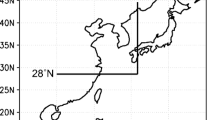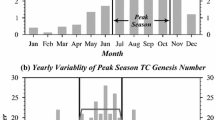Abstract
This study analyzed the climate regime shift using statistical change-point analysis on the time-series tropical cyclone (TC) frequency that affected Japan in July to September. The result showed that there was a significant change in 1995, and since then, it showed a trend of rapidly decreasing frequency. To determine the reason for this, differences between 1995 to 2012 (9512) period and 1978 to 1994 (7894) period were analyzed. First, regarding TC genesis, TCs during the 9512 period showed a characteristic of genesis from the southeast quadrant of the tropical and subtropical western North Pacific and TCs during the 7894 period showed their genesis from the northwest quadrant. Regarding a TC track, TCs in the 7894 period had a strong trend of moving from the far east sea of the Philippines via the East China Sea to the mid-latitude region in East Asia while TCs in the 9512 period showed a trend of moving from the Philippines toward the southern part of China westward. Thus, TC intensity in the 7894 period, which can absorb sufficient energy from the sea as they moved a long distance over the sea, was stronger than that of 9512. Large-scale environments were analyzed to determine the cause of such difference in TC activity occurred between two periods. During the 9512 period, anomalous cold and dry anticyclones were developed strongly in the East Asia continent. As a result, Korea and Japan were affected by the anomalous northerlies thereby preventing TCs in this period from moving toward the mid-latitude region in East Asia. Instead, anomalous easterlies (anomalous trade wind) were developed in the tropical western Pacific so that a high passage frequency from the Philippines to the south China region along the anomalous steering flows was revealed. The characteristics of the anomalous cold and dry anticyclone developed in the East Asia continent were also confirmed by the analysis of air temperature, relative humidity, and sensible heat net flux showing that most regions in East Asia had negative values.









Similar content being viewed by others
References
Cha EJ, Hwang HS, Yang KJ, Won SH, Ko SW, Kim DH, Kwon HJ (2009) Characterisitcs of tropical cyclones over the western North Pacific in 2008. Atmos Chem Phys 19:183–198
Chan JCL (2005) Interannual and interdecadal variations of tropical cyclone activity over the western North Pacific. Meteor Atmos Phys 89:143–152
Chan JCL, Shi JE (1996) Long-term trends and interannual variability in tropical cyclone activity over the western North Pacific. Geophys Res Lett 23:2765–2767
Chia HH, Ropelewski CF (2002) The interannual variability in the genesis location of tropical cyclones in the Northwest Pacific. J Clim 15:2934–2944
Choi KS, Kim BJ et al (2010) Interdecadal variations of tropical cyclone making landfall over the Korean Peninsula. Int J Climatol 30:1472–1483
Choi KS, Byun HR (2010b) Possible relationship between western North Pacific tropical cyclone activity and arctic oscillation. Theor Appl Climatol 100:261–274. doi:10.1007/s00704-009-0187-9
Chu PS (2002) Large-scale circulation features associated with decadal variations of tropical cyclone activity over the central North Pacific. J Clim 15:2678–2689
Elsner JB, Jagger T, Niu XF (2000) Changes in the rates of North Atlantic major hurricane activity during the 20th century. Geophys Res Lett 27:1743–1746
Gray WM, Landsea CW et al (1994) Predicting Atlantic basin seasonal tropical cyclone activity by 1 June. Wea Forecasting 9:103–115
Ho CH, Kim JH, Kim HS, Sui CH, Gong DY (2005) Possible influence of the Antarctic Oscillation on tropical cyclone activity in the western North Pacific. J Geophys Res 110:doi:10.1029/2005JD005766.
Ho CH, Baik JJ, Kim JH, Gong DY (2004) Interdecadal changes in summertime typhoon tracks. J Clim 17:1767–1776
Kalnay E et al (1996) The NCEP/NCAR 40-year reanalysis project. Bull Am Meteorol Soc 77:437–471
Kim JH, Ho CH, Sui CH, Park SK (2005) Dipole structure of interannual variations in summertime tropical cyclone activity. J Clim 18:5344–5356
Kistler R et al (2001) The NCEP/NCAR 50-year reanalysis. Bull Am Meteorol Soc 82:247–267
Knaff JA (1993) Evidence of a stratospheric QBO modulation of tropical convection. MS Thesis, Atmospheric Science Paper No. 520, Colo. State. Univ., Ft. Collins, CO, 80523, 111 pp.
Kwon HJ, Lee WJ, Won SH, Cha EJ (2007) Statistical ensemble prediction of the tropical cyclone activity over the western North Pacific. Geophy Res Lett 34:102–105
Matsuura T, Yumoto M, Iizuka S (2003) A mechanism of interdecadal variability of tropical cyclone activity over the western North Pacific. Clim Dyn 21:105–117
Sheaffer JD (1993) Decadal scale trends in Pacific-Western North America teleconnections and implications for seasonal predictability of anomalous precipitation. Preprints, Fourth Conference on Global Change Studies, Anaheim, CA, January 17-22
Wilks DS (1995) Statistical methods in the atmospheric sciences, Academic Press, 467 pp.
Yumoto M, Matsuura T (2001) Interdecadal variability of tropical cyclone activity in the western North Pacific. Journal Meteor Soc Japan 79:23–35
Zhang G, Zhang X, Wei F (1994) A study on the variations of annual frequency of tropical cyclone in northwest Pacific during the last hundred years. J Trop Meteorol 11:315–323
Author information
Authors and Affiliations
Corresponding author
Rights and permissions
About this article
Cite this article
Choi, KS., Cha, YM., Kang, SD. et al. Interdecadal variation of TC frequency in Japan. Theor Appl Climatol 121, 179–186 (2015). https://doi.org/10.1007/s00704-014-1221-0
Received:
Accepted:
Published:
Issue Date:
DOI: https://doi.org/10.1007/s00704-014-1221-0




